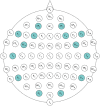Prediction of Pilot's Reaction Time Based on EEG Signals
- PMID: 32116630
- PMCID: PMC7033428
- DOI: 10.3389/fninf.2020.00006
Prediction of Pilot's Reaction Time Based on EEG Signals
Abstract
The main hypothesis of this work is that the time of delay in reaction to an unexpected event can be predicted on the basis of the brain activity recorded prior to that event. Such mental activity can be represented by electroencephalographic data. To test this hypothesis, we conducted a novel experiment involving 19 participants that took part in a 2-h long session of simulated aircraft flights. An EEG signal processing pipeline is proposed that consists of signal preprocessing, extracting bandpass features, and using regression to predict the reaction times. The prediction algorithms that are used in this study are the Least Absolute Shrinkage Operator and its Least Angle Regression modification, as well as Kernel Ridge and Radial Basis Support Vector Machine regression. The average Mean Absolute Error obtained across the 19 subjects was 114 ms. The present study demonstrates, for the first time, that it is possible to predict reaction times on the basis of EEG data. The presented solution can serve as a foundation for a system that can, in the future, increase the safety of air traffic.
Keywords: aircraft control human factors; cognitive workload; data mining; electroencephalography; prediction; reaction time; regression; safety.
Copyright © 2020 Binias, Myszor, Palus and Cyran.
Figures




References
-
- Akerstedt T., Mollard R., Samel A., Simons M., Spencer M. (2003). Meeting to Discuss the Role of eu ftl Legislation in Reducing Cumulative Fatigue in Civil Aviation. Brussels: European Transport Safety Council.
-
- Akhtar M. T., Jung T.-P., Makeig S., Cauwenberghs G. (2012). Recursive independent component analysis for online blind source separation, in 2012 IEEE International Symposium on Circuits and Systems (ISCAS) (Seoul: IEEE; ), 2813–2816.
-
- Allison B. Z., Neuper C. (2010). Could anyone use a BCI? in Brain-Computer Interfaces (London: Springer; ), 35–54.
-
- Alrajhi W., Alaloola D., Albarqawi A. (2017). Smart home: toward daily use of BCI-based systems, in International Conference on Informatics, Health & Technology (ICIHT) (Riyadh: IEEE; ), 1–5.
LinkOut - more resources
Full Text Sources

